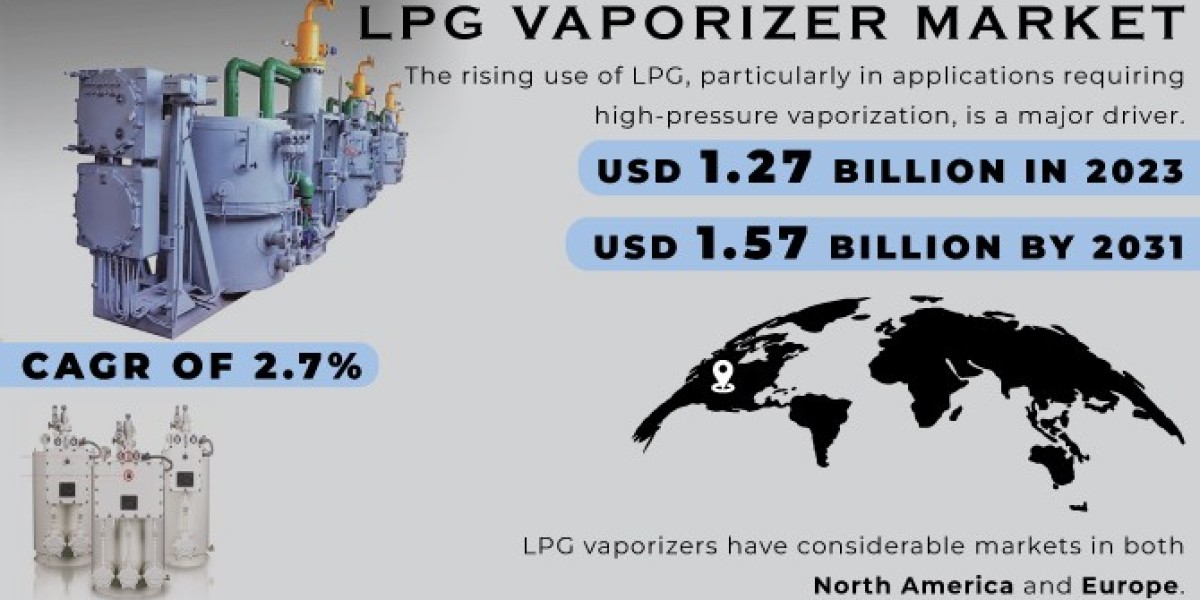LPG vaporizers serve a critical role in various industrial, commercial, and residential applications by converting liquid LPG into gas. This process ensures that the fuel remains available for combustion or other applications, even when natural vaporization falls short due to environmental conditions or high demand. Without vaporizers, LPG systems in colder climates or high-consumption operations could experience interruptions, negatively impacting efficiency and safety. The LPG vaporizer Market Size was valued at USD 1.27 Billion in 2023 and is expected to reach USD 1.57 Billion by 2031 and grow at a CAGR of 2.7% over the forecast period 2024-2031.
How LPG Vaporizers Work
LPG is typically stored as a liquid under pressure. As it is released from its storage container, the liquid naturally vaporizes into gas, but in some cases, this natural vaporization is insufficient, especially in colder climates or during high consumption periods. LPG vaporizers step in by artificially heating the liquid, ensuring it fully converts to gas before being distributed to the system.
Direct-fired LPG vaporizers: These units burn LPG or another fuel to directly heat the liquid LPG. The flame heats the liquid in a heat exchanger, causing it to vaporize. While effective in delivering high volumes of gas quickly, safety precautions are critical, especially in confined spaces where open flames may pose risks.
Indirect-fired vaporizers: In these units, a heat transfer medium like steam or hot water is used to warm the LPG indirectly. This method is safer in environments where open flames could be dangerous, and it’s often used in industries that already have access to steam or hot water systems.
Electric vaporizers: These units rely on electrical heating elements to vaporize the LPG. Electric vaporizers are typically used in residential and commercial settings where electricity is readily available, offering a controlled and consistent gas supply.
Steam/hot water vaporizers: These systems utilize pre-existing heat sources, such as hot water or steam, to vaporize LPG. These are commonly found in industrial settings where steam or hot water is already part of the process.
Each type of vaporizer is selected based on factors like safety, efficiency, and the specific requirements of the installation site.
Applications Across Industries
LPG vaporizers are used across various industries to ensure a consistent gas supply, regardless of environmental conditions or fluctuating demand. They are crucial in settings where fuel availability is essential for operational continuity:
- Manufacturing: Many manufacturing plants use LPG as a primary fuel for heating, drying, and other processes. Vaporizers ensure that the fuel supply remains stable, even during peak demand periods.
- Agriculture: In agricultural applications, LPG vaporizers are used for drying crops, heating greenhouses, and running irrigation systems. By ensuring a steady fuel supply, vaporizers help optimize agricultural productivity.
- Hospitality: Commercial kitchens in hotels and restaurants use LPG vaporizers to maintain a consistent gas supply, especially during peak service hours. This ensures that cooking equipment operates efficiently without interruptions.
- Automotive: LPG-powered vehicles rely on vaporizers to convert the stored liquid into a gas for combustion. This ensures reliable operation, especially in colder climates where natural vaporization may be inadequate.
Environmental and Economic Benefits
The use of LPG vaporizers contributes to environmental sustainability by improving the efficiency of LPG systems, reducing the reliance on fossil fuels like coal and oil. By ensuring that LPG systems operate efficiently, vaporizers help reduce carbon emissions and fuel wastage, contributing to a cleaner and greener environment.
Moreover, the use of LPG vaporizers can lead to significant cost savings. Efficient vaporization prevents fuel loss and ensures that all the LPG in storage is utilized, minimizing waste. In industries where downtime can be costly, ensuring a steady gas supply can also reduce operational interruptions, further boosting productivity and profitability.
Safety and Maintenance
LPG vaporizers are equipped with numerous safety features, including temperature controls, pressure relief valves, and automatic shutdown systems. These features ensure that the system remains safe during operation and that any potential hazards are mitigated. Regular maintenance is necessary to ensure that the vaporizer functions efficiently and safely. Inspections should focus on checking for leaks, ensuring that the heating elements are working properly, and confirming that safety devices like pressure relief valves are in good condition.
Conclusion
LPG vaporizers are indispensable for ensuring a steady, efficient, and safe supply of LPG in a wide range of applications. From industrial manufacturing to commercial kitchens and agricultural operations, vaporizers play a critical role in maintaining energy availability and operational efficiency. As demand for alternative fuels grows, LPG vaporizers will continue to be an important part of the energy landscape, helping industries transition to cleaner and more efficient fuel sources.
About Us:
SNS Insider is one of the leading market research and consulting agencies that dominates the market research industry globally. Our company's aim is to give clients the knowledge they require in order to function in changing circumstances. In order to give you current, accurate market data, consumer insights, and opinions so that you can make decisions with confidence, we employ a variety of techniques, including surveys, video talks, and focus groups around the world.
Contact Us:
Akash Anand – Head of Business Development & Strategy
Phone: +1-415-230-0044 (US) | +91-7798602273 (IND)



